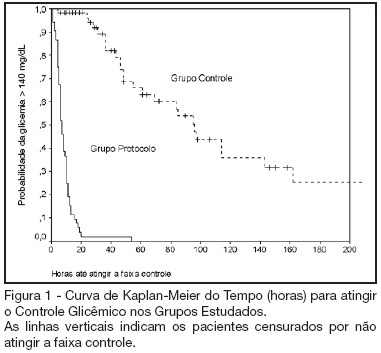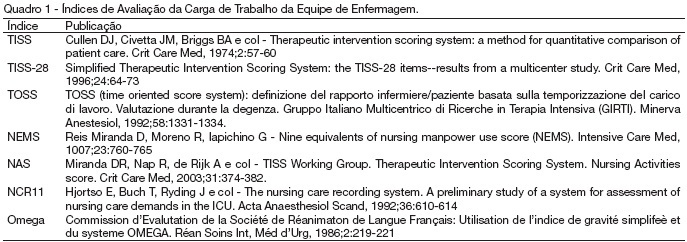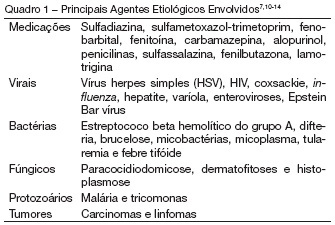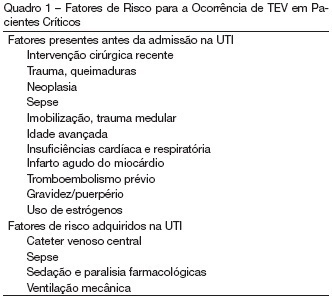Abstract
Rev Bras Ter Intensiva. 2006;18(3):268-275
DOI 10.1590/S0103-507X2006000300009
BACKGROUND AND OBJECTIVES: Actually tight glycemic control is a major concern in critical care. The objective of this study was to evaluate effectiveness and safety of Yale insulin infusion protocol in a Brazilian medical and surgical intensive care unit. METHODS: Retrospective, before-after cohort study. Selected end-points were mean blood glucose levels, time-to-reach target range of 80 - 140 mg/dL, and percent of blood glucose in target range and hypoglycemia incidence. RESULTS: Were studied 112 patients: 60 in control group (CG) and 52 in protocol group (PG). Bedside blood glucose was measured 5392 times for a mean value of 131.2 ± 14.7 mg/dL in the PG versus 2485 times for a mean value of 181.7 ± 36.1 mg/dL in the CG. Blood glucose values were in the target range 65% and 32% of the times, respectively for PG and CG groups (p < 0.001). The median time to reach glucose target range was 7 h (range 4 -10 h) for PG and 96 hr (range 46 - 278 h) for CG (p < 0.001). Incidence of severe hypoglycemia did not reach difference statistically significant: 4 patients in PG versus 2 patients in CG. CONCLUSIONS: Yale insulin infusion protocol was effective and safe to improve blood glucose control in a Brazilian medical and surgical intensive care unit.

Abstract
Rev Bras Ter Intensiva. 2006;18(3):276-281
DOI 10.1590/S0103-507X2006000300010
BACKGROUND AND OBJECTIVES: ICU is the hospital sectors that have interrupt assistance. Assistance with quality is a challenge for those who run human resources. It is also important to know the risk of the patient to the better use of resources. The aim of this study is to identify most used severity indexes in intensive care and classify them according with their finality METHODS: Library research (medline), using the key words: "Scoring systems and ICU". The articles were selected in the period from March to May 2005. Books and thesis were also used. RESULTS: We identify seven indexes evaluating nursing workload: TISS, TISS-28, TOSS, NEMS, NAS, NCR11, and Omega. We identify 21 indexes evaluating clinical status: Killip Glasgow CRI APACHE II e III, Ransom, SS, SSS, SAPS, MLR, MPM, LIS, ARPI, SAPS (II), MPM II, ODIN, Ontario, MODS, SOFA, LOD, and PSI). CONCLUSIONS: Although indexes evaluating nursing workload are in a lower number, they are also fundamental to preview the need for material and human resources.

Abstract
Rev Bras Ter Intensiva. 2006;18(3):282-291
DOI 10.1590/S0103-507X2006000300011
BACKGROUND AND OBJECTIVES: Perioperative renal dysfunction is an important cause of morbidity and mortality. With increase of life expectancy, older patients with more co-morbidity are being submitted to high risk surgical procedures, what make clinical practice related to organ protection possible modifier of short and long term survival. This review about renal protection in surgical intensive care unit points risk factors and discusses scientific evidence related to reduction of renal dysfunction in perioperative. CONTENTS: Although low extraction and adequate renal reserve of oxygen, the kidney is extremely sensible to hypoperfusion being renal acute insufficiency a frequent complication of hemodynamic instability. This apparent paradox, high oxygen content and reduced extraction with high incidence of renal damage to hypotension reflects the intra-renal gradient of oxygen, what makes renal medulla highly susceptible to ischemia. Factors associated with renal lesion are observed in all fases of perioperative period: fasting, contrast use, hypovolemia, hypotension, catecholamine and cytokine release, extracorporeal circulation, trauma, rabdomiolisys and aortic clamp. CONCLUSIONS: Management of renal damage is based in principals of perioperative renal physiology and glomerular hemodynamic. Clinical practice directed to organic protection should be implemented to minimize the impact this dysfunction.

Abstract
Rev Bras Ter Intensiva. 2006;18(3):292-297
DOI 10.1590/S0103-507X2006000300012
BACKGROUND AND OBJECTIVES: The Stevens Johnson Syndrome (SJS) and Toxical Epidermal Necrolisys (TEN) are important skin and mucosal lesions that need intensive care treatment. The aim of this article is to show a literature review about SJS and TEN. CONTENTS: This article reviews the concepts, diagnostic topics, clinical presentation and the principle of basic treatment in Intensive Care Unit for SJS and TEN. CONCLUSIONS: These illnesses are characterized as dermatological emergencies and its adequate management and cares must be part of the routine knowledge of the intensive care doctors.

Abstract
Rev Bras Ter Intensiva. 2006;18(3):298-306
DOI 10.1590/S0103-507X2006000300013
BACKGROUND AND OBJECTIVES: Nutritional state of patients affects them in their clinical evolution. Protein-caloric malnutrition contributes to the increase of morbidity and mortality in critical care. Regardless all the parameters available to assessment, there is no standard in hospital centers. In this review, we were looking for a method to nutrition assessment (NA) in critical patient that allow more adequate assessment and contribute to improvement in critical care. CONTENTS: In order to compare methods in NA in critical patient, search was performed in scientific papers aboutthis area. The keywords usedwere nutritional assessment, critical patient, critical care, hospital undernourishment and anthropometry. CONCLUSIONS: There are restrictions to different anthropometric parameters for NA when referring to critical patients. There is no consensus within authors about the best method for these patients and they no advise to choose only one parameter. We suggest for practice clinical in NA, one tool that include objective and subjective aspects in critical patients and identify those that are either undernourishments or in nutritional risks (Appendix 1).
Abstract
Rev Bras Ter Intensiva. 2006;18(3):307-310
DOI 10.1590/S0103-507X2006000300014
BACKGROUND AND OBJECTIVES: The diffuse axonal polyneuropathy, more commonly known as Critical Illness Polyneuropathy (CIP), has been discussed by authors by decades; however, it has only been deeply studied over the last thirty years, becoming more important as an important cause of long term dependence on mechanical ventilation by seriously ill patients in intensive care medicine. CONTENTS: A significant reason for such interest is due to the importance of the CIP as complication of the septic shock and in patients with multiple organ failure, as much as responsible for the prolonging hospitalization in the Intensive Care Unit, as for the gradual reduction of the chance of survival. It has been suggested that the polyneuropathy is related with cytokines and other mediators which would increase the permeability of the vases, resulting in endoneural edema and causing the axonal injury. It is difficult to do the initial diagnostic, which, in general, are only possibly recognized when the sepsis complications or the multiple organs failure have been satisfactorily controlled. The diagnosis is made through the eletroneuromiography exam, and although there is still no effective drug treatment other than the control of the basic illness, it is consensus among multidisciplinary team that the development of the CIP does not have to be understood as a way to reduce the intensity of treatment. CONCLUSIONS: Spit of your prevalence, it is still unknown the mainly factors which are physiopathology associated as soon as your correct therapy.
Abstract
Rev Bras Ter Intensiva. 2006;18(3):311-315
DOI 10.1590/S0103-507X2006000300015
BACKGROUND AND OBJECTIVES: Gas embolism is an iatrogenic injury that has high morbidity and mortality. It's a complication of clinical-surgical procedures, and it's necessary that the health professionals know this entity. The aim of this study was to realize a review of the gas embolism, considering its pathophysiology, diagnosis and therapeutics aspects. CONTENTS: This article revises conceptually the gas embolism, dividing it in arterial and venous. Relate the mains physiopathology, diagnosis and therapeutics characteristics of the arterial and venous embolism. In addition, it's also approach the paradoxical embolism, event that occurs by conversion of a venous embolism to an arterial embolism. CONCLUSIONS: Gas embolism is an important complication, and it's present in many medical specialties. Knowledge about its physiopathology, and its diagnosis and therapeutic methods is essential to guarantee higher safety to the patients.

Abstract
Rev Bras Ter Intensiva. 2006;18(3):316-319
DOI 10.1590/S0103-507X2006000300016
BACKGROUND AND OBJECTIVES: Venous thromboembolism (VTE), with includes deep vein thrombosis (DVT) and pulmonary embolism (PE), is a common complication in critically ill patients, resulting in high morbidity and mortality. CONTENTS: Most patients treated in intensive care units (ICU) face a high risk of thromboembolic complications. Despite these considerations, the prevention of VTE may not be as high a priority in ICU patients as it is in other high-risk patient groups. Low molecular weight heparin (LMWH) may be the optimal prophylaxis in most ICU patients, but there is a lack of sufficient data including the paucity of VTE consensus and guidelines documents pertaining to critically ill patients. CONCLUSIONS: This article reviews background, current options, and recommendations regarding VTE in intensive care population emphasizing special diagnostic and treatment considerations in the ICU setting.
